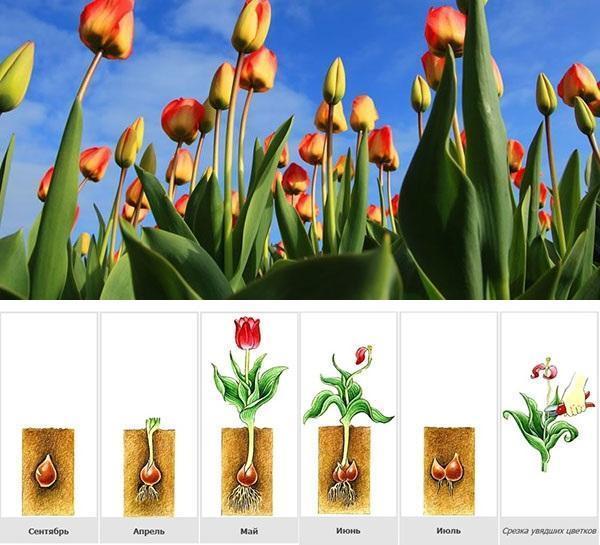Tulips and 10 cycles of their life - from planting to digging
 Tulips, like people, have their own way of life. Only an experienced gardener can make it as successful as possible. For this, it is important to know all the intricacies of planting, care and digging this flower. Ten simple tips will help you make the process fun and with the best results.
Tulips, like people, have their own way of life. Only an experienced gardener can make it as successful as possible. For this, it is important to know all the intricacies of planting, care and digging this flower. Ten simple tips will help you make the process fun and with the best results.
Video: when to dig tulips after flowering?
Tulips - the path from a bulb to rebirth
Every florist dreams of having luxurious blooms in his flower bed, of course, much more beautiful than that of a neighbor. Therefore, a competent approach to caring for plants will become the golden key in this matter. Here are the main stages of a tulip's life.
The soil
Sandy loam soil with the introduction of humus (peat, compost) is best suited to the culture. Acidity index: 7-8 pH. The land must be well drained. Clayy, heavy and watertight types of soils are loosened with sand.
Life span
In one place, a culture can live up to 3 years. Then it loses its decorative effect: the buds become smaller, and the underground part begins to rot and die off. The reason is that the bulbs are dividing exponentially, so they lack nutrients.
Boarding time
It is carried out in the middle of autumn, when the soil temperature becomes 7-10 ° C. If you do this earlier, the bulbs will begin to sprout. Both early and late vegetation will lead to freezing. It is necessary to plant the plant at such a time that the bulbs can take root, but at the same time they do not have time to put down the leaves. The gardener calculates the date according to the climate of his region.
Before planting, the storage temperature and the soil itself are practically leveled, which serves as a guarantor of luxurious buds and the absence of empty ovaries.
Geometric landing calculations
First, the height of the fruit is determined: from the bottom to the tail. Then multiply the result by three. This will be the depth of the fossa, that is, 3 of its bulbs. Tulips are planted in 10 cm increments, so as not to separate the bushes later.
Winter period
Tulips can easily tolerate temperatures as low as -5 ° C. However, in regions where the thermometer shows -10 ° C, you need to cover the front garden with mulch. It is formed from branches, straw, peat or humus (height from 8 cm).
Diet
The first feeding for a set of green mass is carried out during the period when the leaves rise 10 cm from the ground. After loosening, nitrogen or organic fertilizers (1 part mullein for 10 hours of water). The second - before flowering using potash preparations with the calculation of 30 g per 1 m² (or 50 g / m² of ash is diluted in a bucket of water and water the bushes with 800 ml). Fertilize the third time after flowering, so that good bulbs are laid. Both phosphorus and potassium are taken at 30 g / m².
Removing seed bolls
If the stalks are not cut, they will absorb all the energy that is destined for the underground part of the plant.
Digging
The culture must finally mature. Yellowed leaves and wilting stems are the first signs for digging.
Storage ritual
After digging, the bulbs are left in the ground for half an hour. When they warm up, they are removed to a well-ventilated room with a temperature of 23-25 ° C. By the end of summer, it should be already 20 ° С, and from September - 15 ° С.
Design ideas
The decorative properties of tulips are obtained through special planting conditions.Bulbs of the same size are planted in one hole with an interval of several centimeters. They are pre-calibrated. Plant babies are grown separately in special schools. They only need to be deepened by 5-8 cm.
Adhering to the listed recommendations, the gardener will make their spring flower bed ideal. Gorgeous red or pink tulips will sparkle elegantly in the bright sun.